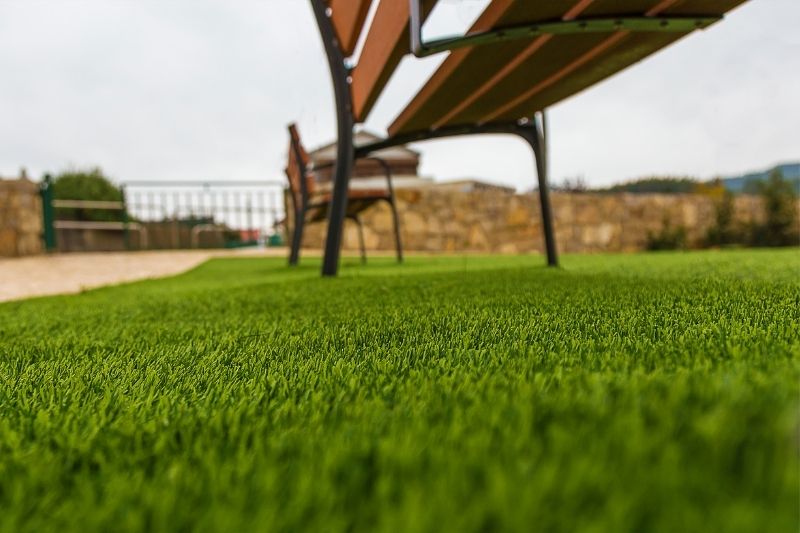Artificial Grass vs. Synthetic Turf: Unveiling the Differences
Artificial grass and turf are great substitutes for real grass and sod if you're searching for a quick and simple approach to make your lawn and garden seem better. Understanding the distinctions between the two materials is crucial before making any changes to your grass. Though they resemble each other in a few respects, these artificial grasses are very distinct.
What Is Artificial Grass?

The term "artificial grass" describes synthetic grass blades that are designed to resemble real grass. A combination of UV-resistant and weather-resistant nylon, polypropylene, or polyethylene fibres make up this material. The basic goal of artificial grass is to produce lush, green lawns that don't require constant upkeep like fertilizing, watering, or mowing.
What Is Artificial Turf?

The term "artificial synthetic grass turf," on the other hand, is more inclusive and includes the backing structure and filler beneath the fake grass blades. Artificial turf is made consisting of grass blades together with a backing that keeps the entire construction together and a base layer that provides support. This backing is usually made of sand or rubber. Due to its sturdy design and long lifespan, "artificial turf" is frequently connected to playgrounds, sports fields, and other high-traffic locations.
Distinguishing Features
1)Composition
- Artificial Grass: Artificial grass is primarily designed to mimic the look of real grass. It is composed of man-made fibres, typically derived from polyethene or polypropylene, that have been meticulously engineered to replicate the colour, feel, and durability of genuine grass.
- Artificial Turf: Synthetic grass, a base layer, an infill substance, and a drainage system make up an artificial turf system. Stability is provided by the base layer, resilience, and stress absorption are improved by the infill material, and water accumulation is avoided by the drainage system. Although it is a vital component, artificial turf systems consist of a more complex framework that includes synthetic grass.
2)Durability and Performance
- Artificial Grass: Artificial grass cannot be as durable as an artificial turf system, even though it is made to endure frequent foot activity and weather exposure. It works well with light to moderate usage.
- Artificial Turf: Perfect for playgrounds and sports fields, artificial turf systems are designed to withstand extensive use and are optimized for high-performance applications. The additional layers help to improve shock absorption and durability.
Also, Read:-
What Goes Under Artificial Grass?
A Step-By-Step Guide To Laying Artificial Grass On Concrete
Artificial Grass Cost Estimation For Your Artificial Lawn
Top 10 Things To Know Before You Buy Artificial Turf For Dogs And Pets
3)Maintenance Requirements

Artificial Grass: Artificial grass's low care requirements are one of its main benefits. To keep it appearing brand new, it needs to be cleaned, brushed, and occasionally have infill replenished.
Artificial Turf: Artificial turf installation may need extra attention because of the added components, even if they are still very low-maintenance when compared to natural grass. For best results, regular grooming, redistributing infill, and checking the underlying layers are necessary.
Artificial Grass Vs. Turf: What About Looks?
Artificial Turf
Its real appearance is a major factor in its popularity among homeowners. The dark green color of turf sometimes prevents it from having the same variances as natural grass.
It's a great option if you want something that looks like grass but doesn't require as much upkeep. On the other hand, turf may be a good option if your pets frequently tramp on your grass or if you primarily utilize your yard as a play area or putting green grass.
Artificial Grass
Installing artificial grass on lawns has advanced significantly. It even flows with the breeze to give a genuine look because it is made of softer yet incredibly sturdy materials. That makes it the perfect choice for anyone who desires the aesthetic appeal of real grass without having to put in the work to maintain it.
Turf usually has a single, uniform colour that is present over the whole surface. With fake grass, you can select settings that let you have different green hues that resemble real grass.
Choosing The Right Option
After discussing the differences between artificial grass and artificial turf, you may be wondering which is best for your particular need. To make an informed choice, take into account the following factors:
1)Intended Use
- Artificial grass can be a better choice if you're searching for landscaping for a commercial location or home lawn with little foot activity.
- An artificial turf system is the better option because of its increased durability for playgrounds, sports fields, and locations with heavy traffic counts.
2)Budget Constraints
- In general, artificial grass is less expensive than a complete artificial turf system. Deciding to use artificial grass could make sense if cost is a major factor.
Artificial grass and artificial turf differ in the context of landscaping solutions not only in terms of naming but also in the finer points of composition, uses, durability, and upkeep needs. The decision between the two is based on your personal preferences, needs, and how you want to use the surface.
Both artificial grass and artificial turf offer a lush, green substitute for natural grass without the headaches of ongoing upkeep, whether you choose the more straightforward option of artificial grass or the more intricate system of artificial turf. You may make an informed choice that supports your landscaping objectives and guarantees a colourful and durable surface for many years to come by being aware of the subtle differences between these phrases.
Also, if you are looking for good options for Rugs, Carpets, and Vinyl Flooring please click below to visit:








